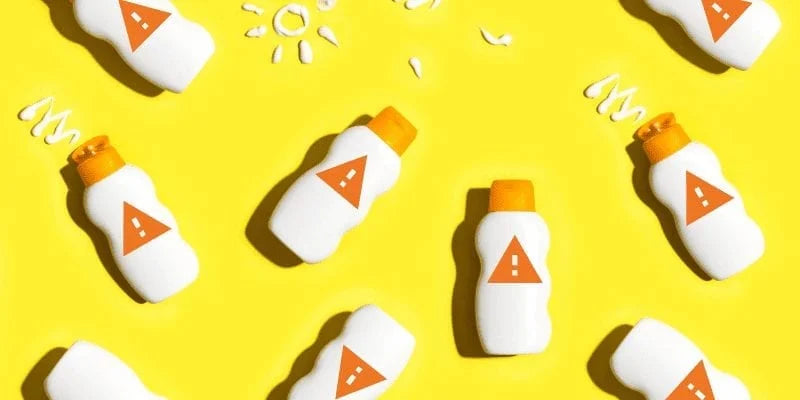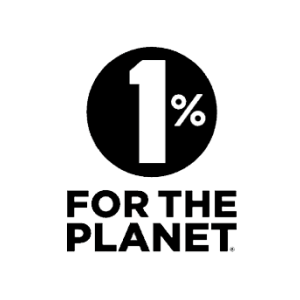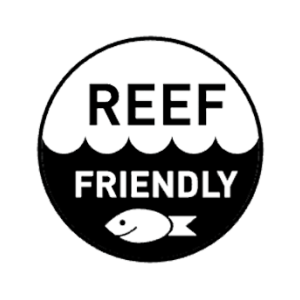There’s almost no point in wearing sunscreen when the ingredients are just as harmful as the sun. You wear sunscreen to protect your skin — so why poison it with chemicals?
Unlike mineral sunscreens (us) that sit on top of your skin and offer protection by reflection, most conventional sunscreens (them) are made with chemicals that actually absorb into your skin and block the UV rays after the rays have entered your skin! You’ll see these sunscreens referred to as “UV absorbers.” AKA: Sunscreen made with chemicals that are small enough to absorb into your skin — and the rest of your body.
Quick science lesson: How does sunscreen affect your body?
The moment you lather on chemical sunscreen, your skin starts absorbing the ingredients. How do we know? Because these chemicals have been measured in the body through blood, breast milk, and urine samples (it’s a dirty job, but somebody’s gotta do it). The Food and Drug Administration (FDA) has found that some of these ingredients enter the bloodstream at levels far beyond what the recommended FDA-established thresholds. These sunscreen chemicals have been found to cause hormone disruptions that shift estrogen levels, affect thyroid function, and create molecules that can cause premature aging (no thanks!). And if it’s not good for you, it’s likely not good for our oceans. Here’s where we break down the effects these chemicals have on our coral reefs.
So what are the most harmful chemicals in sunscreen?
1. Oxybenzone
Oxybenzone — or as we like to call it, Public Enemy #1 — is one bad apple, and is just as harmful to humans as it is to coral reefs.

According to the Center for Disease Control (CDC), 97 percent of Americans have this chemical circulating in their bodies and it comes with a slew of nasty side effects: it’s considered a hazardous eye irritant, a skin allergen, can disrupt estrogen production in women and testosterone production in men, and has been linked to thyroid problems in both men and women. There’s even mounting concern that oxybenzone causes skin cancer and poorer reproductive success in men.
Oxybenzone dramatically weakens coral-based ecosystems by speeding up coral bleaching and death. Studies show that this chemical not only kills adult coral but also damages DNA in young coral, which affects development and lifespan. It’s so detrimental that Hawaii, Palau, Key West, the US Virgin Islands have banned all sunscreens containing oxybenzone and octinoxate (more on that later).
That’s one un-friendly chemical! That’s why we will never ever (EVER!) make sunscreen with oxybenzone in it. 100% of our All Good sunscreens are oxybenzone-free sunscreens.
2. Octinoxate
Octinoxate — also referred to as Octyl methoxycinnamate (OMC) on some labels — is the Bonnie to oxybenzone’s Clyde. It works with oxybenzone as a UV-filtering chemical and is absorbed quickly and effectively through the skin. Once inside your body, octinoxate mimics the hormone estrogen which can lead to complications in thyroid function and cardiovascular disease. And like oxybenzone, it’s also known to cause endocrine disruption. No thanks!
3. Octocrylene
Octocrylene might sound like a Jurassic Park marine creature, but it’s just another chemical that absorbs right into your skin. This puppy can trigger harmful reactions in cells that may lead to cardiovascular disease. And, yep — you guessed it: it’s toxic for marine life. Scientists found that this chemical can accumulate over time in coral tissue as fatty acids and impair the normal functioning and metabolism of corals. If it’s not good for corals, it’s probably not good for you.
4. PABA (Aminobenzoic Acid)
Now this one is tricky because Aminobenzoic Acid —also known as Para-Aminobenzoic Acid or PABA —is an organic compound naturally found in grains, eggs, milk, and meat. And while it’s considered non-toxic to humans in small amounts, the Haereticus Environmental Laboratory (HEL) has included it in its list of reef-harmful substances for its damaging effects on coral reefs. When you wear this chemical in the ocean, it’s a one-way ticket to coral damage, so cross it off the list.
5. Enzacamene
Add Enzacamene to the list of endocrine disruptors. It mimics estrogen in the human body and disrupts the thyroid and reproductive organ function (not cool). Oh, and it’s also non-biodegradable (super not cool). And like other endocrine-disrupting ingredients on this list, enzacamene has a devastating effect on coral, triggering bleaching and eventually death. This is a common ingredient found in sunscreens and cosmetics so read those labels!

6. Octisalate
Octisalate is like the X-Men of chemical sunscreen ingredients: it’s a colorless liquid that absorbs UV rays, makes sunscreens water-resistant, and also enhances skin’s permeability to make it easier for other UV absorbers to enter your body. WHAT?! Studies show that octisalate can negatively impact your immune system and trigger allergies. Several countries like Japan and Canada already recognize it as an environmental toxin.
7. Homosalate
Like octisalate, homosalate is a UV absorber that helps other sunscreen ingredients penetrate your skin. That’s why it’s widely used in any cosmetic products containing “SPF.” And, unsurprisingly, there is evidence suggesting homosalate affects hormone function (are you seeing a pattern yet?). This particular effect mimics estrogen in the body, making your body react like it has an excess of estrogen which can lead to contaminated breast milk and breast cancer.

8. Avobenzone
For all our sensitive skin friends, you will especially want to avoid avobenzone (PSA: no relation to avocados). Avobenzone is a UV-ray blocker that is sometimes used in place of Oxybenzone, but like Oxybenzone, it penetrates the skin to allow other chemicals to follow suit. Recent studies found that Avobenzone can cause skin allergies when it breaks down in the sun, and can be toxic to liver and kidneys if it comes into contact with chlorine… which is a common ingredient in swimming pools and tap water. Sort of makes you wonder why it would be in a sunscreen at all?
This is by no means an exhaustive list of harmful ingredients in sunscreens, but it’s a good place to start. There are plenty of Parabens (preservatives commonly used in cosmetics) and Phthalates (synthetic fragrances) that we also steer clear of. Read the labels of any products you put on your skin and do your research — even the products that are labeled “natural” and “organic.” Take your health into your hands.
So what is the safest way to protect against the sun?
Look for mineral-based sunscreens that do not use any of the “Awful Eight” ingredients listed above. Mineral sunscreens work topically on the skin’s surface, acting as a repellant and physical barrier to the sun’s rays — protection by reflection. All of our All Good Sunscreen are proudly non-nano particle zinc sunscreens — and you better bet they’re broad spectrum!
Also good ol’ physical barriers: Wear a hat, wear lightweight long sleeves, bring an umbrella or sit in the shade. It’s not all about sunscreen — it’s about creating a barrier between your body and the sun. So be smart and avoid too much sun exposure between 10AM – 2PM, when UV rays are typically at their strongest.
Incorporate all these chemical-free tactics into your skin care routine. You’ll protect your skin from sun damage and the dangers of skin cancer all without exposing your body to dangerous chemicals on the inside. It’s a win-win-win.







